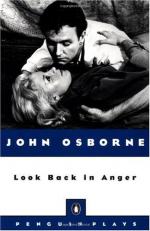|
This section contains 5,869 words (approx. 20 pages at 300 words per page) |

|
SOURCE: Watson, George. “Osborne, Pinter, Stoppard.” In British Literature since 1945, pp. 145-74. Houndmills, England: Macmillan Press, 1991.
In the following excerpt, Watson asserts that Look Back in Anger played a seminal role in the revival of British theater in the mid-1950s.
The story of London theatre, by common consent, divides at 1956, when John Osborne's Look Back in Anger opened at the Royal Court Theatre.
May 1956 was a moment of change, even revolutionary change; and like many revolutions, it was also a reaction. Before it, a more formal theoretical tradition had tried to restore an Elizabethan sense of poetry to audiences hungry for colour and style. The post-war verse plays of T. S. Eliot and Christopher Fry were born of austerity: in Eliot's case they were an attempt, partly successful, to reach audiences larger than his poetry was ever likely to enjoy; in Fry's, to remind a public battered...
|
This section contains 5,869 words (approx. 20 pages at 300 words per page) |

|


